|
Boletín de la Sociedad Geológica Mexicana Volumen 74, núm. 3, A080422, 2022 http://dx.doi.org/10.18268/BSGM2022v74n3a080422
|
 |
Soil modification in the manufacturing process of Mesoamerican earthen architecture
Modificación de suelos en el proceso de manufactura de la arquitectura mesoamericana de tierra
Annick Daneels1, Marta Mateu2, *, Hugo Fernández3, Salvador Piña4, Héctor Cabadas-Báez5
1 Instituto de Investigaciones Antropológicas, Universidad Nacional Autónoma de México 04510, Ciudad de México, Mexico.
2 Postdoctoral Fellow CONACyT CB2015-254328 project, UNAM 04510, CDMX, Mexico.
3 Independent Researcher, Zacatecas, Mexico.
4 Independent Researcher, CDMX, Mexico.
5 Laboratorio de Geología, Facultad de Geografía, Universidad Autónoma del Estado de México, 50110, Toluca, Estado de México, Mexico.
* Corresponding author: (M. Mateu) This email address is being protected from spambots. You need JavaScript enabled to view it.
How to cite this article:
Daneels, A., Mateu, M., Fernández, H., Piña, S., Cabadas-Báez, H., 2022, Soil modification in the manufacturing process of Mesoamerican earthen architecture: Boletín de la Sociedad Geológica Mexicana, 74 (3), A080422. http://dx.doi.org/10.18268/BSGM2022v74n3a080422
Manuscript received: December 15, 2021; Corrected manuscript received: February 21, 2022; Manuscript accepted: March 15, 2022.
ABSTRACT
This paper presents a micromorphological analysis of a sample series from three Mesoamerican earthen architecture sites. It compares a soil, a sample from a construction fill and a sample of a soil mixture used for mud-brick and facing, resulting from different manufacturing steps. The purpose is to identify the soil features that remain and those that are transformed in the process. This is of interest both to geologists, who encounter anthropically modified soils, and archaeologists interested in understanding the provenance of the raw materials and the manufacturing processes. In contrast to previous research based predominantly on earthen architecture from Europe and the Near East, this study is the first comparative analysis of Mesoamerican sites, where earthen construction developed independently from the Old World, using volcanic soils developed in a range of tropical environments. The results show that similar building techniques existed in different environments, that the non-expansive clays and fine fraction derived from volcanic deposits may have presented advantages for construction, while some features reflect the addition of mineral or vegetal temper to improve the mechanical properties of some soils.
Keywords: micromorphology, construction techniques, volcanic soils, geoarchaeology, Mexico.
RESUMEN
En este artículo se presenta un análisis micromorfológico de una serie de muestras de tres sitios arqueológicos mesoamericanos de arquitectura en tierra. Se comparan muestras de suelo local, con muestras de rellenos constructivos y de mezclas constructivas para adobes y repellos elaborados en diferentes etapas de manufactura. El objetivo es identificar los rasgos de suelo que se conservan y aquellos que se transforman en este proceso. Esto es interesante tanto para geólogos que estudian los suelos modificados antrópicamente, como para los arqueólogos interesados en entender la procedencia de las materias primas y los procesos de manufactura. En contraste con las investigaciones anteriores de arquitectura de tierra, enfocadas sobre todo en Europa y el Próximo Oriente, este estudio es el primer análisis comparativo de sitios mesoamericanos donde la arquitectura de tierra se desarrolla independientemente del Viejo Mundo, usando suelos volcánicos desarrollados en varios ambientes de la zona tropical. Los resultados muestran que existen técnicas constructivas similares en diferentes ambientes, que las arcillas no expansivas de la fracción fina derivadas de los depósitos volcánicos presentan ventajas para la construcción, mientras que otros rasgos reflejan el añadido de minerales o de vegetales para mejorar las propiedades mecánicas de algunos suelos.
Palabras clave: micromorfología, técnicas constructivas, suelos volcánicos, geoarqueología, México.
- Introduction
The application of micromorphology to study earthen architecture starts in the Old World some 30 years ago (e.g., Cammas, 2018; Friesem et al., 2017; Karkanas and Goldberg, 2019). The study of the micromorphological features that allow to identify construction material (both fills and building materials) is incipient in America and mostly addresses construction fills from the more classic geological approach of Anthrosols, to determine the source of the building material or the environmental conditions. Important works dealing with North America include Ortmann and Kidder (2013) on mound-building in the Mississippi valley, and Cremeens (2005) on the Cotiga Mound in West Virginia. In South America, there are studies on the montes in the Amazon or the coastal sambaquis (Pugliese et al., 2017; Villagran et al., 2009).
Archaeologists, on the other hand, are also interested in understanding the social aspects of obtaining the raw materials and transforming it into a building material to infer labor investment, building logistics, and workforce control. Defining the manufacturing process allows to identify the building techniques and place them within the scope of Mesoamerican architectural traditions, that include mud-brick and cob, and the application of continuous facings to walls, slopes and floors alike. In America, micromorphological studies focusing on the identification of specific construction techniques are still scarce. Compared to the abundant publications in the Old World, in Mesoamerica (a cultural area extending from the southern half of Mexico to the Pacific watershed of Costa Rica), there are only a few studies, that analyze construction samples from one or two sites. Following list covers most of the published data: Houston et al., 2003 in Kaminaljuyú; Rivera et al., 2007, and Stahlschmidt et al., 2019 in Teotihuacan; Goldberg, 2009, Karkanas and Goldberg, 2019: 134, fig. 3.57a-b, in Río Viejo, Oaxaca; Gama et al., 2012, Zethé and Sabina Grande in the Valle del Mezquital, Hidalgo; Liberotti and Daneels, 2012, La Joya and Arslantepe; García-Zeferino et al., 2018 and Solleiro-Rebolledo et al., 2021, La Joya and Tres Mezquites; Mateu and Daneels, 2020, La Joya and Teotihuacan. Only Mateu and co-authors (2022) make a comparison of construction samples from seven Mesoamerican sites, but do not analyze the angle of the provenance and the transformation of the raw material.
This paper will present a micromorphological analysis of the changes occurring at each step of the manufacturing process in the different building techniques used in Mesoamerican earthen architecture, by comparing, in three archaeological sites, samples of the original raw material in its geological context, the earthen architectural fills in the buildings, and construction mixtures prepared for mud-brick walls and facings. It uses the analytical procedure developed by European teams for the micromorphological study of earthen architecture sites in the Old World, here applied to sites from Mesoamerica, where this tradition developed independently. The examples were selected to show that similar building techniques existed using local soils in different environments, that the non-expansive clays and fine fraction derived from volcanic deposits may have presented advantages for construction, and that it is possible to identify features that reflect the deliberate addition of mineral or vegetal temper to improve the mechanical properties of some soils.
- Materials and methods
The study uses a series of eight thin sections from three sites (Table 1; Figure 1), from geological profiles, archaeological fills, and samples from mud-bricks or facings. These were selected from a universe of about 100 construction samples from 14 mostly Classic period sites distributed evenly among humid and semiarid environments in Mesoamerica (from Zacatecas to El Salvador), but all situated in volcanic regions, obtained as part of CONACyT Project CB2015-254328. They are described using the standard micromorphological protocol (Bullock et al., 1985; Courty et al., 1989; Stoops, 2003 and Verrecchia and Trombino, 2021), adding the features determined by Cammas (2018) that make it possible to determine the mixture of soils of different provenance, the intentional inclusion of mineral or organic additives, the amount of water added to obtain the required texture and the stress indicators that reflect the direction and intensity of the energy used during the manufacture and building processes (Table 2).
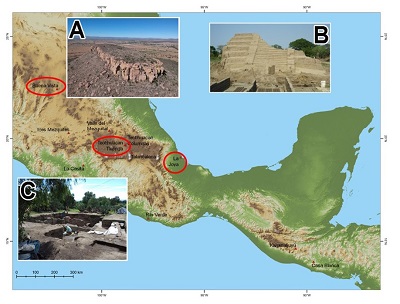 |
| Figure 1. Location of sites mentioned in the text, with general views of the archaeological sites: A) Buenavista, B) La Joya, and C) Teotihuacan (G. Jiménez, based on INEGI map, photos by G. Fernández, A. Daneels and C. Carballo, respectively). Images reproduced with permission of Instituto Nacional de Antropología e Historia, México (INAH). |
| Table 1. Description of archaeological sites, with references for archaeological and soil information. |
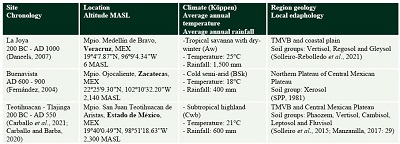 |
The samples were selected from sites where thin sections of the three types of material existed, either obtained in the project or previously published: La Joya, Teotihuacan and Buenavista, all Classic period sites (first millennium AD). La Joya has a monumental earthen architecture compound located on the humid tropical coastal plain of the Veracruz Basin, 6 km from the Gulf of Mexico, at the confluence of the Jamapa and Cotaxtla rivers, both originating on the flanks of the Pico de Orizaba volcano, part of the Transvolcanic Belt (Gómez et al., 2005). The initial construction starts on the top of a paleodune, surrounded by alluvial sediment (García-Zeferino et al., 2022; García-Zeferino, 2020; Piña, 2021). The archaeological excavations revealed a clear stratigraphy of four major building phases, ranging from 200 BC to AD 1000, during which time the site functioned as a regional capital (Daneels, 2011). During the third building stage, artificial water reservoirs were dug through the alluvial sediment around the monumental compound of the site and were kept inundated through a hydraulic system catching the overflow from the Jamapa river; the gleyic strata that formed in these reservoirs were later also used as building material. The building materials thus came from different geological sources: sand and clay-enriched B-horizon from the paleodune, alluvial sediment from the river terraces and gley from the reservoirs.
For this paper we selected thin sections obtained from the paleodune (B horizon) to compare with the components of a sandy fill with subrounded clayey soil blocks removed from the argillic horizon, and with a sample of mud-brick.
Buenavista, a small archaeological site close to Ojocaliente in Zacatecas, occupied AD 600-900, is on an isolated volcanic outcrop located in the Mesa Central region of Mexico (Nieto et al., 2005), surrounded by alluvial sediment of a minor affluent of the Lerma-Chapala drainage. Fernández (2004) suggests that the outcrop itself is a volcanic formation of rhyolithic composition, associated to the Cenozoic. Samples were obtained from the river bed nearest the site, as well as from the fill of the main structure and from an architectural facing.
The famous pre-Columbian metropolis of Teotihuacan is located in the semi-arid Central Mexican highlands, to the north of the endorheic Mexico Basin, on a valley floor along the San Lorenzo river, surrounded by volcanic outcrops of the Transvolcanic Belt (Ferrari et al., 2012). During the climax of the city (AD 300-600), buildings of the northern part of the city were built on top of the tepetate (volcanic tuff) subsoil, after clearing the paleosol that was used as fill material for the pyramids. The stratigraphy of the Teotihuacan Valley has been thoroughly studied (Rivera et al., 2007; Solleiro et al., 2011; Sánchez et al., 2013), and their information will be used to compare the Black San Pablo Paleosol (BSPP) with the fill of the Pyramid of the Moon, and two mud-bricks from a compound to the south of the city, in the Tlajinga barrio.
These three series show how it is possible to evaluate that the raw material for building was obtained from natural geological sources in the immediate vicinity of the site, and how the three main steps of the manufacturing process affected the appearance of the original soils: material supply (extraction, transportation, tamping), production (combining soils, adding water, optionally adding mineral or organic components, pugging), and application (compaction by gravity, compressing by hand, compressing or smoothing with an instrument).
Additionally, micromorphological analysis also reveals features that develop during the use and after the abandonment of the building. The three sites will show similarities, as they are all located in geological surroundings conditioned by volcanic sediments (the Transvolcanic Belt and the Mesa Central), but with different environmental and topographical characteristics; the construction techniques are similar: the fills are obtained by extraction, transport and tamping, and the building samples selected of mud-brick and facings (also called plasters or renders) both required the preparation of a soil mix in plastic state by adding water and thorough pugging, and the possible addition of mineral or vegetal components. Thus, it is possible to compare features that define raw material, and their transformation through similar manufacturing processes, across a range of Mesoamerican sites.
The thin sections were prepared in the micromorphology workshop of the Institute of Geology at the Universidad Nacional Autónoma de México, following standard protocols (Loaiza and Poch, 2015: 19-20; Verrecchia and Trombino, 2021), and observed under a petrographic optical microscope, in Plane Polarized Light (PPL), between Crossed Polarizers (XPL) or Oblique Incident Light (OIL).
- Results
In this section we present the description of the three sample types from each site, in order to offer a comparison showing the features that appear during the different steps of the production process (Table 2).
| Table 2. Micromorphological description. |
 |
3.1 LA JOYA
3.1.1 RAW MATERIAL
The first sample is from the B horizon of the paleodune in an area exposed by the brick-makers (Piña, 2021)1. It is important to take into account that the sample location corresponds to an exposed profile below the Pyramid, which in its final stage was at least 20 m high and 50x50 m at the base, representing a volume of 18,500 m3 of compacted earth (Daneels, 2016: 670) or almost 30,000 tons weighing down on the paleosol. The sample consists of yellow sandy clay, archaeologically sterile. Micromorphologically, it has a subangular structure with a tendency to be massive, with thin aligned planes and vughs (35-40% porosity). The coarse fraction consists of fine sands, with an average size of 0.15 mm in diameter, composed of rounded rocks, plagioclase, pyroxenes, micas and scarce amphiboles (Figure 2A-2B); there are some clay coatings and infillings with strong birefringence that clearly indicate the in situ development of the B horizon of the paleodune (Figures 2C-2D).
1 Since the 19th century, the archaeological mounds of the region have been exploited as borrow pits to obtain the raw material to make bricks.
 |
| Figure 2. Photomicrographs of raw material from La Joya: paleodune. Massive microstructure and sandy composition (A: PPL and B: XPL, Mateu), clay coatings (C: PPL and D: XPL, J. Díaz). |
3.1.2 ARCHITECTURAL FILL
Researchers have studied distinct architectural fills from this site (García-Zeferino et al., 2018; García-Zeferino, 2020; García-Zeferino et al., 2022). This case will reexamine sample B2 from the plaza fill of the third building stage. The sample was taken from the upper section of profile 1, from 140 cm below the modern surface, 80 cm above the first plaza floor built during the second building stage immediately over the site’s original paleosol (Figure 3). It is yellow sandy loam, with sub-rounded clayey soil blocks, 2-5 cm in diameter; it was inferred that the matrix came from the paleodune C horizon, while the dark clayey soil blocks are fragments removed from the argillic B horizon or from gley horizons in the reservoir (García-Zeferino et al., 2022). The thin section B2 (Figure 3A) shows a subangular structure with abundant pores. The size of the coarse fraction corresponds to fine sands, and represents 30%; its distribution is not homogenous, but banded.
The porosity is 35%; there are planes and vughs oriented horizontally, parallel to the surface, while scattered throughout the groundmass there are some chambers and vughs. In the upper part of the sample there are little accumulations of sands in bands (also parallel to surface). There are charcoal fragments (Figure 3B) and rounded silty aggregates, as well as Fe/Mn ox(hydr) impregnations; there are also anthropic components such as sherds or obsidian fragments (archaeological artifacts made of volcanic glass). Significantly, most silty coatings do not follow the orientation of the sample, indicating removal (Figures 3C and 3D). The whole sample is quite bioturbated with fresh organic matter.
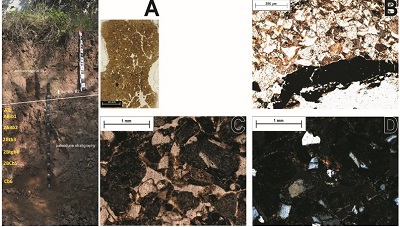 |
| Figure 3. Sample B2 (fill). Profile (left, paleodune stratigraphy and photo by T. García, 2020; García-Zeferino et al., 2022), A) thin section (we can see porosity: chambers, planes and vughs) (Daneels and Díaz). Photomicrographs: B) detail of charcoal (PPL, J. Díaz), C-D) microstructure and clay coatings (PPL and XPL, J. Díaz). Images reproduced with permission of INAH. |
3.1.3 BUILDING ELEMENT
In this case, we selected a mud-brick from the East Platform (reference code LJ4-2188) with a sandy groundmass and a massive microstructure. The porosity is 25%, formed by vesicles, vughs, planes and some moldic voids of fine vegetal tempers, more obvious macroscopically in the fresh fracture, where it represents up to 20% of the groundmass.
The coarse fraction represents 30%, in close porphyric c/f related distribution pattern. This coarse fraction is moderately sorted fine sands with a certain dominance of quartz and feldspathic particles (Figure 4). Its b-fabric is granostriated and undifferentiated. Such fabric is characteristic the degradation of volcanic glass, forming halloysite clay with a high component of amorphous-allophane fraction (Joussein et al., 2005). The presence of halloysite has been corroborated via XRD analyses of the fine fraction on most sites, including the three analyzed in this article (Pi, 2018; Pi et al., in press; Girón, 2021; Mateu et al., 2022). Clay infillings are found in some pores, and there is some bioturbation. In the upper part (parallel to the surface of the mud-brick) different layers can be observed according to granulometry: on the surface there is a layer of fine material about 200 µm thick, which has an abrupt lower limit and is followed by a layer of sands without fine fraction, then a plane void and finally the matrix of the material with the characteristics already explained above (sandy groundmass with granostriated-undifferentiated b-fabric and massive microstructure) (Figure 4E-4F) (Piña, 2021).
 |
| Figure 4. Photomicrographs of mud-brick (LJ4-2188): microstructure and sandy-loam groundmass (A: PPL and B: XPL, Piña), granostriated b-fabric (C: PPL and D: XPL, Piña). E: Thin section, F: photomicrograph of surface layer of the mud-brick (PPL, Piña). Images reproduced with permission of INAH. |
3.1.4 COMPARISON
The fill sample B2 has sedimentary properties similar to the paleodune B horizon, but the structure is fragmentary by effect of extraction and transportation, and there are typical pores of deposition: vughs and planes (and some chambers). Certain technological features are visible: in the upper part of some samples there are some horizontal planes and even some intercalations that could come from the compression of the material itself during deposition.
There is no vegetal temper, but ceramic sherds, organic matter and charcoal are present. The composition of the mud-brick is similar to what we see above: both the sands and the finest fraction, the ratio between them, as well as the b-fabric are similar to the fill, and to the paleodune itself. But it contains visible anthropic components (like those found in the fill), although smaller in size, and shows a more homogeneous internal organization and distribution, as a result of the preparation and application of this mixture (technological aspects). It also has vegetal tempers (moldic voids) added to the mixture, and some residual aggregates of fine fraction (silty-clay). These technological aspects we will be analyzed in more detail in the discussion. No complete microlaminated clay coatings were identified, only reworked clay coatings, indicating that natural edaphic features were deformed or fragmented by the mixing process.
3.2 BUENAVISTA
3.2.1 RAW MATERIAL
As it would be the closest source of sediment available, the sample MG2 was taken at a depth of 150 cm from a profile of the Ganzules riverbed, which flows along the northern part of the hill (Figures 5 and 6A). It is a fairly compact sample with a groundmass of subangular and angular rocks, gravel, pebbles and sands, with a sandy-clay texture. Its porosity is caused by roots, and it appears to contain some layers (Fernández, 2021). Micromorphologically (Figure 6B), it is composed of coarse fraction (between 30-35%) of gravel and coarse sands, with a subangular and subrounded morphology. The color varies between light and dark brown (PPL), with little birefringence (XPL), while its c/f related distribution pattern is double-spaced and close enaulic. In general, it has a sandy-clay groundmass with a complex microstructure, from more compact and massive to granular (Figures 6C and 6D).
 |
| Figure 5. Georeferenced location of samples of Buenavista: geologic sample on the side of the river (MG2) and fill sample on the top of the hill (MG1). The rectangles show the excavated areas of the site (Fernández based on Google Earth). |
It has a porosity percentage of 15-20% of channel, complex packing voids and vughs. There are local accumulations of dark Fe/Mn ox(hydr) nodules. Banded silty-clay aggregates were also observed (Figures 6C and 6D), along with reworked clay coatings and clay coatings formed around weathered minerals. All of these represent an alluvial sedimentary sequence.
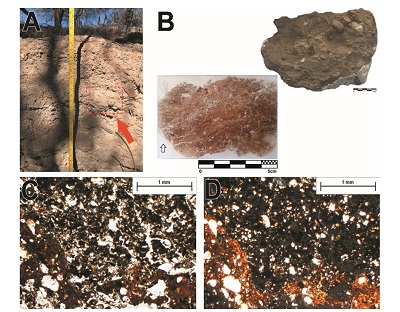 |
| Figure 6. MG2, raw material from Buenavista. A) Profile (Fernández), B) sample and thin section (complex microstructure) (Fernández), and C-D) photomicrographs: granular to massive microstructure, banded silty-clay aggregates (PPL and XPL, Fernández). |
3.2.2 ARCHITECTURAL FILL
The sample (MG1) comes from the fill of the artificial mound supporting structure 1, which is located at the top of Cerro La Mesilla (Figure 5) and was taken at a depth of approximately 28 cm below surface (Figure 7A). Macroscopically, its composition is quite homogeneous: a silty-sandy matrix with some gravel, in general very porous (the porosity is caused by insect holes and roots).
Micromorphologically (Figures 7B-7F) this sample has a coarse fraction proportion of 35%, composed of gravel and coarse sands, subangular and subrounded. The fine fraction ranges from light to dark brown (PPL) and presents little birefringence (XPL). Its c/f related distribution pattern is double-spaced and close enaulic. It presents a sandy-loamy groundmass of complex microstructure (massive to granular) (Figures 7C-7D), with a porosity of 20% of planes, vughs and complex packing voids (Figures 7E-7F). There are dark brown impregnative nodules of Fe/Mn ox(hydr). Aggregates of finer material with an irregular morphology are observed, as well as yellow reworked clay coatings of subangular and rounded shapes. It is very bioturbated and heterogeneous, with roots, excrement, porosity, etc. (Figures 7C-7F).
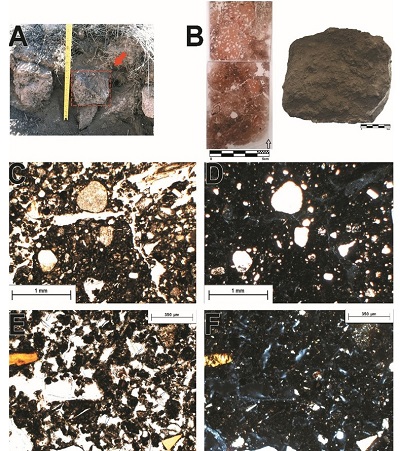 |
| Figure 7. MG1, fill sample. A) Profile (Fernández), B) sample and adjoining thin sections (heterogeneous groundmass and complex microstructure) (Fernández), and C-F) photomicrographs (C-D: microstructure, roots – PPL and XPL; E-F: detail of bioturbation with packing voids – PPL and XPL, Fernández). |
3.2.3 BUILDING ELEMENT
The building sample taken from the Buenavista site (ZAC9) is a facing (Figure 8A-8B). It has a massive microstructure with low porosity and nearly the entire groundmass is composed of fine coarse fraction of very fine sands of quartz, plagioclase and volcanic glass (volcanic ash). Most of the 25% of porosity is composed of moldic voids that come from vegetal temper (we show regular pore type, and phytoliths residues and charred remains in these pores – Figure 8C-8D, 8G-8H). In this case, the origin of the raw material is evident from these rounded residual aggregates of volcanic glass shards (Figure 8E-8F). Mixing and application can be observed in the exterior (surface) layer of the facing, which is of finer material than the rest with a smooth surface (Figures 8C-8D).
 |
| Figure 8. Facing ZAC9 of Buenavista (construction element). A) sample, B) thin section: reddening and in the rectangle, evidence of the mixing process, C-D) photomicrographs of surface of sample (PPL and XPL), E-F) rounded residual aggregate (volcanic glass) (PPL and XPL), G) phytolith (PPL) and H) charred remains (PPL). Fernández and Mateu. Images reproduced with permission of INAH. |
Additionally, the groundmass shows evidence of reddening or rubefication caused by the fire that destroyed the building (as documented by archaeologists) (Figure 8A-8B).
3.2.4 COMPARISON
There is no direct correlation between the raw material and the two construction samples. Volcanic glass sands (ash) are nearly absent in the geological sample, while the fill contains a few fragments of volcanic glass shards and small fragments of pumice, and the facing is dominated by a large amount of fine volcanic glass sands. The fill and the facing contain fragments of gravel and coarse sands with subangular shapes, and also a few fragments of anthropic components. In the fill there are some fragments of charcoal and bone; their orientations and dispositions in the groundmass could indicate he relocation of the material. Thus, the building elements presented more volcanic shards in their groundmass, even in the form of accumulations, and it appears this volcanic ash must have been added intentionally to the silty-clay alluvial material.
Such volcanic ash is associated to the ancient volcanism in the Mesa Central region of Mexico, related to rhyolithic magmas erupted during the Cenozoic (Nieto-Samaniego et al., 2005); that material could be associated to alluvial deposits (formed by the erosion of the highlands) or obtained from in situ ash layers and added intentionally. In short, the groundmass resulting of this facing is very fine material with little coarse fraction and without birefringence (XRD analyses have resulted in clays with a predominance of halloysite -Pi, 2019; Pi et al., 2022), as well as residual aggregates of volcanic glass, which suggests an origin in the volcanic soils of the region.
3.3 TEOTIHUACAN
3.3.1 RAW MATERIAL
In the case of Teotihuacan, the raw materials consist of two soil horizons studied by Rivera et al. (2007). One horizon is the Black San Pablo Paleosol (BSPP) (dark grayish brown, with a structure of subangular blocks and high porosity) and the other a petrocalcic horizon (hardened calcic horizon) (Figures 9A-9D). In addition, we have a fragment of tepetate or volcanic hardpan from Tlajinga (Figures 9E-9F), that has low porosity with a high proportion of coarse fraction, mostly is weathered, and has an orange fine fraction without birefringence.
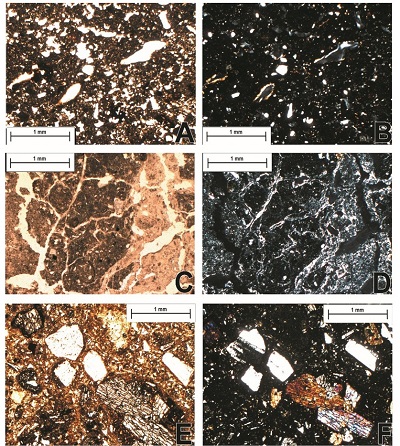 |
| Figure 9. Photomicrograph of Teotihuacan raw material. Photomicrographs of Black San Pablo Paleosol: dark groundmass with high porosity (A: PPL and B: XPL). Petrocalcic horizon: limpid yellow clay coatings (note strong interference colors of the clay coatings) (C: PPL and D: XPL). Tepetate: coarse fraction and orange fine fraction without birefringence (E: PPL and F: XPL). Mateu. |
3.3.2 ARCHITECTURAL FILL
Rivera et al. (2007) analyze a series of samples from the fills of the Pyramid of the Moon, observing edaphic material with “typical features of the superficial organo-mineral horizons (Ah). The matrix is pigmented with dark-colored dispersed humus, but the fills present characteristics of human activity: mainly charcoal fragments and agrocoatings” (Figure 10). They consider that the fills used for the pyramid construction come from superficial and intermediate horizons from the surrounding soils, hardpan (tepetate) and mud-bricks (Rivera et al., 2007).
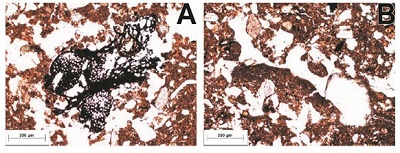 |
| Figure 10. Photomicrographs of Teotihuacan fill (Pirámide de la Luna), A: charcoal fragment (PPL), B: agrocutan (PPL) (based on Rivera et al. 2007: 216, Figura 10); reproduced with express permission of the BSGM editor-in-chief. |
3.3.3 BUILDING ELEMENT
For comparison we use two mud-bricks from the Tlajinga area (TLAJ1 and TLAJ2) (Figure 11A-B). Both are similar in composition: plagioclase and pyroxene sands, with fragments of pumice and basalt, and a fine fraction without birefringence, without limpidity, dotted, in polarized light (Figure 11C-D). This is indicative of the halloysite clay and amorphous-allophanes typical of the local soils (Girón, 2021; Pi et al., 2022).
They have some charcoal, ceramic fragments and some moldic voids. We also observed residual aggregates of both a more dark-colored silty-sandy matrix (Figures 11E-11F) and a more clayey matrix (petrocalcic) (Figures 11G-11H). The difference between the mud-bricks is that the second one (TLAJ2) has a fine fraction with slightly more birefringence than the first one (TLAJ1).
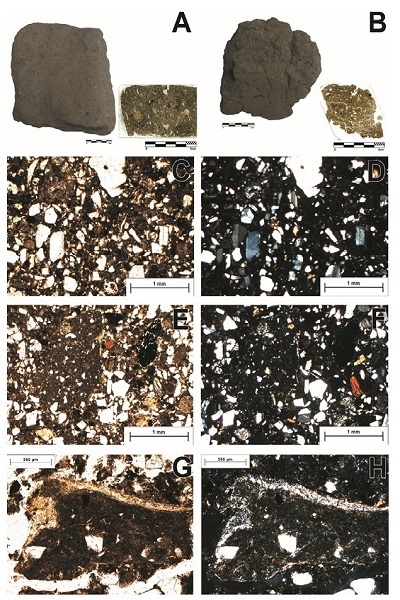 |
| Figure 11. Mud-brick photomicrographs. A) sample TLAJ1 and thin section, B) TLAJ2 sample and thin section, C-D) TLAJ1 microstructure (PPL and XPL). E-F) sandy loam residual aggregate (TLAJ1, PPL and XPL). G-H) clay residual aggregate (from petrocalcic sediment) (TLAJ2, PPL and XPL). Mateu. Images reproduced with permission of INAH. |
3.3.4 COMPARISON
The mud-bricks shows residual aggregates from other types of soils that were used to make these mixtures: some petrocalcic/pedogenetic carbonate (Solleiro-Rebolledo et al., 2011) and some darker silty ones that could come from the BSPP paleosol (Sánchez-Pérez et al., 2013; Solleiro-Rebolledo et al., 2011). In the case of the fills used in the Pyramid of the Moon, they do not appear to be exactly the same material as the mud-bricks since the latter are sandier, but both have the same characteristic dark color caused by organic matter. Thus, it appears that Teotihuacan builders used similar soils for mud-bricks and fills. For the mud-bricks they use silty-sandy sediments (with abundant fine sands) without vegetal tempers and they probably added a siltier sediment, perhaps from the paleosol or from superficial horizons from surrounding soils (after removing most of the topsoil-humus, according to ethnographic data), as well as more clayey sediments from these petrocalcic horizons, as evidenced by either rounded or banded residual aggregates of these two sediments.
- Discussion
These examples show the differences between the three stages in the manufacture process, from the earth in a “natural state”, an architectural fill, extracted, transported and compacted, and a prepared construction mix, pugged and kneaded, and with organic or mineral tempers occasionally added.
Table 3 summarizes the different characteristics between raw materials and how these are modified in fills and construction elements. Evidently, in each site, there will be different characteristics according to the types of soils, sediments and pedogenetic processes, as pre-Columbian societies used local soils and sediments for their constructions. In the present case, two of the three sites are located in similar geological environments of the Transvolcanic Belt, while the third is associated to older volcanic events, which gives them a certain similarity in terms of basic mineralogy, while the pedogenetic processes will differ depending on the environment and vegetation. But, as they modify them in the process of construction, other micromorphological characteristics appear.
| Table 3. Micromorphological differences between fills and construction elements. |
  |
The selected materials are sufficiently similar to their original geological deposition, that it is possible to locate from where they were obtained from the immediate surroundings to the site (normally <1 km, as otherwise labor investment becomes too high to be practical): paleodune sands and B-horizon in the case of La Joya, paleosol and petrocalcic horizons in Teotihuacan, alluvial sediments with and without volcanic ashes in Buenavista. In the construction mixes, it is possible to observe extraneous components of mineral or vegetal origin, like volcanic ash or chopped grass, present as a major component in the sample, but that are not part of the original soils; these are interpreted as temper, intentionally added to increase mechanical performance of the building material. In contrast, while both fills and mud-brick or facing mixes will generally contain some anthropic remains (bone fragments, charcoal, obsidian, etc.), these are so scarce and occasional in the construction mixtures that they must have been accidentally added.
In the case of fills, the microstructure will range from massive to granular, depending on how much they were compacted by stamping with the feet during building. Evidence of extraction, transportation and stamping of soils in fills are: clay coatings that are not in their “natural” orientation/position due to gravity processes, as well as more vugh type pores. For example, while the paleodune at La Joya is archaeologically sterile, the fill sample B2 has evidence of material of anthropic origin, including large sherds, obsidian and charcoal, that must have been introduced when the material was extracted and redeposited in the plaza fill (García-Zeferino et al., 2022). These characteristics may appear also in layers of collapsed buildings, but this aspect has to be corroborated by archaeological work.
The construction elements have massive microstructures, with porosity depending on the construction technique. In the case analyzed in this article, both mud-bricks and facings need to reach a plastic state for their manufacture, which requires the addition of enough water to make a malleable mixture that does not crack, but also does not become viscous or liquid.
This is reflected in its low porosity, consisting mainly of vesicular and moldic voids (from the added vegetal tempers). In the case of the mud-bricks analyzed in this article, the addition of these vegetal tempers would not be so necessary because they are sandy (although it is a fine or very fine sand); however, regular moldic voids are detected, as well as phytoliths or carbonized remains in them, that show that chopped grass was added intentionally. In some samples, as in the Buenavista facing (ZAC9), vesicular pores may derive from these vegetal tempers. The vesicles are normally indicative of the hydric state (Mateu et al., 2022), but in this case they are more regular and have a similar diameter, so that they may be transversal cuts of the elongated moldic voids (Figure 8). The mud-bricks may have some accidentally added anthropic components (ceramic fragments, bone, etc.), but this is rarely in the case in facings, which are usually much more selected and possibly sieved mixtures. The groundmass of these construction mixes can also have residual aggregates of fine fraction, which are relicts from the raw materials (from different horizons or sediments), that were not disaggregated and integrated into the mix.
Such pedofeatures described serve to identify the provenance of the raw material and to infer the manufacturing processes of architectural fills or mixes (Table 4). Using the manufacturing process approach, we can observe the different micromorphological characteristics resulting from the transformation of raw materials through processing: extracting, transport, tamping, pugging, kneading, smoothing, adding vegetal or mineral temper.
| Table 4. Manufacturing process to obtain construction elements in plastic state (mud-bricks and facings). Micromorphological characteristics by production step with the examples of the samples of the article, including use and abandonment features. |
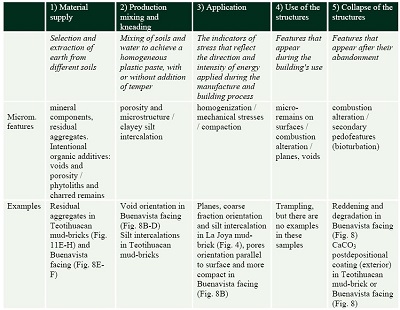  |
In the first step, material supply, the micromorphological features indicate soil provenance, mineral components, and residual aggregates.
The latter are present in all our series. These rounded aggregates show us how the material was mixed and where the soil came from. All samples are volcanic materials and soils, and it is important to determine their pedogenesis. On the one hand, the coarse fractions come directly from the volcanic fragments of rock, and the fine fraction consists of clay formed by the weathering of volcanic rock, and in all cases include halloysite and allophanes. The most salient feature to differentiate between a natural soil and a fill is the contorted or fragmented state of natural pedofeatures. It is also very important to remember that earthen construction will mix soils from different provenance, both in fills as in construction products like mud-bricks and facings; in this respect, observation of residual aggregates is important, besides the general mineralogical composition.
The second step is production. The most salient feature is the homogenization of the construction mix, where it is especially important to estimate the degree of humidity (Mateu et al., 2022) by observing the microstructure and porosity. In terms of the mixture, clayey silt intercalations in wavy or curved lines in the mass of the sample (not along the surface or sides) are indicative of kneading process in a mixture with varying degrees of humidity. Karkanas (2019) considers that such intercalations can have different causes, some of them natural; however, in these cases their orientation in the construction sample clearly indicate directions and forces during preparation of the mix (production) and application: some are from smoothing, and are parallel to the surfaces, other come from kneading, leaving curvilinear patterns.
The second most important aspect is the identification of the intentional mineral or organic additives. These can be volcanic shards (Buenavista), while chopped grass is a recurrent additive, identified by a characteristic porosity, the pore type (moldic voids), and phytoliths residues and/or charred remains in the pores.
The next step is the application: the actual building process, with the surface finish. The micromorphological features are (1) indicators of stress that reflect the direction and intensity of energy applied, (2) those related to mechanical stress. For example, on the upper surface of the mud-brick is a layer of fine materials from the sweeps of the hand to smoothen the topmost layer, and on the bottom, pores are flattened from compression by gravity and/or compaction. Clayey silt intercalations, aligned with the surface of the construction elements, are indicative of building processes (the making of mud-bricks, the raising of a mud-brick wall with mud mortar, the facing of surfaces with mud plaster). Such features are not found as such in the fill, much less in the banks from which the material may have been extracted.
The following step in the logic of the manufacturing process involves the use of the structure. In the samples (mud-bricks and facings) presented here, this step is not clearly visible, but other studies report characteristics of the use of floors, for example, finding micro-remains or plane voids parallel to the surface that would indicate trampling (Cammas, 2018).
The last step in the life of a building is its abandonment. In our examples there are alterations due to a fire (Buenavista) and secondary pedofeatures like the CaCO3 postdepositional coating on the external part of the mud-brick (Teotihuacan). Finally, an earthen building will return to form part of the soil, and it is possible to identify postdepositional processes in the surface that affect these buried materials (bioturbation).
- Conclusions
The work has brought us closer to a micromorphological characterization of the features of fills and construction elements, defining the differences and modifications of the original raw material in their sequence of manufacture and use. This type of analysis is so far scarce in Mesoamerica, and comparative studies are virtually non-existent. In this article, a selection of three series of samples is compared, to show how manufacturing features of particular construction techniques (stamped fills, mud-brick and facings derived from soil mixes in a plastic state) are identifiable even from sites from different climatic or geographical environments.
In this case, the three sites selected use mainly soils derived from the Mexican Transvolcanic Belt and the Mesa Central, with volcanic minerals and clays of low birefringence. As indicated, parallel XRD analysis has identified in all samples the presence of halloysite, a non-expansive clay characterized by its low birefringence. The use of stable clays would be an important factor in the success of earthen construction, but its effects on mechanical performance will have to be analyzed by methods other than micromorphology.
The results presented in this article show its potential for the study of the earthen architecture, since it informs on the provenance of the raw material, from different sources that must be identified in the immediate surroundings of the site.
The raw material in the fills will appear almost in its original composition, but the evidence of extraction and transfer will be apparent in the modification of the shape of the pedofeatures formed by the action of gravity (like the microlaminated clay coatings), and the presence of artifacts of obviously human origin such as ceramics or lithics.
The alternating superposition of layers of soils of different origins and textures should be analyzed as an intentional strategy to control the internal pressure of the fills, since it cannot be interpreted as the result of a process of soil formation of natural origin.
The construction techniques of mud-bricks and facings require to process soil into a plastic state to achieve an adequate building material; this generally requires the mixing of soils of different origin, which will not necessarily be the same as the fills, but must also come from an environment close to the site. In this case, the identification of the extraction banks is more subtle.
The materials are then mixed with water and pugged until a fairly homogeneous plastic mixture is obtained (more so in the case of facings than mud-bricks). This process disaggregates many of the original pedofeatures, leaving only occasional residual aggregates that turn out to be of importance for the identification of the provenance of the different materials. Texture and porosity are key features to understanding these manufacturing processes.
Beyond these, the intentional addition of tempers and other features will reflect different ways of doing things in each site or region. Among them is the addition of mineral or vegetal components (volcanic ash, chopped grass), which may or may not occur. These will be the particularities that define regional practices within the major building traditions shared by all earthen architecture in Mesoamerica, regardless of their environment, such as the use of mud-bricks and the application of mud-plasters (facings).
With the example of these series from three archaeological sites, comparing natural soils with architectural fills and building mixes, this contribution presents an analytical procedure that is of interest to both geologists and archaeologists. Until now, edaphologists have mainly examined the anthropic modification of surface soils resulting from agricultural practices or residential or production activities, to determine human impact or reconstruct paleoclimate.
The case of earthen architecture does not fall within the usual definition of anthrosols, but it is certainly a case of soils modified by humans for specific purposes, that will be found in close association with “classic” Anthrosol.
Yet, as indicated, the study of the micromorphological features that allow to identify construction material (both fills and building materials) is incipient in America.
Archaeologists, on the other hand, will be interested in understanding the provenance of the soils, to infer social and manufacturing process (labor investment, building logistics, workforce control); the manufacturing process will identify the building techniques and place them within the scope of Mesoamerican architectural traditions, while differences will define local or regional practices of cultural importance to understand technological developments and transfers.
Contributions of authors
Conceptualization: AD, MM, HF, HC; analysis or data acquisition: MM, HF (Buenavista), AD and SP (La Joya); methodological/technical development: MM, AD, HC; writing of the original manuscript: MM, AD, HC; writing of the corrected and edited manuscript: AD, MM; graphic design: MM; fieldwork: HF (Buenavista), AD and SP (La Joya), MM (Teotihuacan); interpretation: AD, MM, HF, SP, HC; financing: AD.
Financing
CONACyT project CB 2015-254328, 2016-2021: AD director, SP and HF undergraduate grantees, and MM postdoctoral fellowship.
Acknowledgments
The authors acknowledge the Archaeological Council of the National Institute of Anthropology and History for the permission to carry out the excavations, sampling and analysis of the materials. The archaeological artefacts presented in the figures of this article are reproduced with the authorization of the National Institute of Anthropology and History, of the Ministry of Culture of Mexico, in accordance with the Federal Law on archaeological, artistic and historical monuments and sites and its regulations. Also, we would like to thank the archaeologists who provided the samples: D. Carballo (Teotihuacan) and G. Fernández (Buenavista). At the UNAM, Dr. S. Sedov and M.Sc. J. Díaz, of the Institute of Geology, assisted in preparing the thin sections, granted access to the Microscopy Laboratory, and in particular collaborated in the study of La Joya, helping to take samples and providing a first description and interpretation; in this regard, we also recognize the contribution of M.Sc. T. García-Zeferino. Marta Mateu acknowledges the grant offered by the postdoctoral fellowship program of the National Autonomous University of Mexico at the Institute of Anthropological Research (2019-2021).
Conflicts of interest
The authors have no conflicts of interest to disclose.
References
Bullock, P., Fedoroff, N., Jongerius, A., Stoops, G., Tursina, T., 1985, Handbook for soil thin section description: Wolverhampton, UK, Waine Research Publications, 152 p.
Cammas, C., 2018, Micromorphology of earth building materials: Toward the reconstruction of former technological processes (Protohistoric and Historic Periods): Quaternary International, 483, 160-179. https://doi.org/10.1016/j.quaint.2018.01.031
Carballo, D., Barba, L., 2020, Informe Técnico del Proyecto Arqueológico Tlajinga Teotihuacan. Cuarta Temporada, 2019 submitted to the Consejo de Arqueología INAH: Ciudad de México, Boston University and Universidad Nacional Autónoma de México, 216 p.
Carballo, D., Barba, L., Ortiz, A., Blancas, J., Hernández, D., Codlin, M.C., Saucedo, A., Torres, G.D., 2021, Excavations at the Southern Neighborhood Center of the Tlajinga District, Teotihuacan, Mexico: Latin American Antiquity, 32(3), 557-576. https://doi.org/10.1017/laq.2021.17
Courty, M., Goldberg, P., Macphail, R., 1989, Soils and micromorphology in archaeology: Cambridge, Cambridge University Press, 364 p.
Cremeens, D.L., 2005, Micromorphology of Cotiga Mound, West Virginia: Geoarchaeology: An International Journal, 20, 581–597. https://doi.org/10.1002/gea.20069
Daneels, A., 2007, Monumental earthen architecure at La Joya, Veracruz, Mexico: Crystal River (FL), Foundation for the Advancement of Mesoamerican Research, Crystal River. http://www.famsi.org/reports/07021/07021Daneels01.pdf
Daneels, A., 2011, Arquitectura cívico-ceremonial de tierra en la Costa del Golfo: el sitio de La Joya y el urbanismo del periodo Clásico, in Robles García, N.M., Rivera-Guzmásn, A. I. (eds.), Monte Albán en la encrucijada regional y disciplinaria. Memoria de la Quinta Mesa Redonda de Monte Albán: México, Instituto Nacional de Antropología e Historia, 445-478.
Daneels, A., 2016, Juego de pelota y política. Un estudio sobre cómo se desarrolló la sociedad del periodo Clásico en el centro de Veracruz: Mexico, Instituto de Investigaciones Antropológicas, Universidad Nacional Autónoma de México, 693 p.
Fernández, G., 2004, Proyecto arqueológico Ojocaliente (Estado de Zacatecas) segunda temporada de Campo. Report submitted to the Consejo de Arqueología: México, Archivo Técnico de la Coordinación de Arqueología del Instituto Nacional de Antropología e Historia.
Fernández, H., 2021, Procesos de manufactura de arquitectura de tierra por análisis micromorfológicos a partir de muestras de sitios arqueológicos del Clásico en zonas semiáridas de México: Zacatecas, México, Universidad Autónoma de Zacatecas, Unidad Académica de Antropología, Tesis licenciatura, 152 p.
Ferrari, L, Orozco-Esquivel, M.T., Manea, V., Manea, M., 2012, The dynamic history of the Trans-Mexican Volcanic Belt and the Mexico subduction zone: Tectonophysics, 522-523, 122-149. https://doi.org/10.1016/j.tecto.2011.09.018
Friesem, D., Wattez, J., Onfray, M., 2017, Earth Construction Materials, in Nicosia, C., Stoops, G. (eds.), Archaeological Soil and Sediment Micromorphology: Hoboken, Wiley, 99-110.
Gama, J., Cruz y Cruz, T., Pi Puig, T., Alcalá, R., Cabadas, H., Jasso, C., Díaz, J., Sánchez, S., López, F., Vilanova, R., 2012, Arquitectura de tierra: El adobe como material de construcción en la época prehispánica: Boletín de la Sociedad Geológica Mexicana, 64 (2), 1077-1188. https://doi.org/10.18268/bsgm2012v64n2a3
García-Zeferino, 2020. El suelo como fuente de materia prima en la arquitectura de tierra de Mesoamérica antigua: México, Universidad Nacional Autónoma de México, Tesis maestría, 145 p.
García-Zeferino, T., Daneels, A., Díaz, J., Solleiro-Rebolledo, E., 2022, Use of sediments and soils (paleosols) in construction fills of La Joya archaeological site, Veracruz, Mexico: micromorphological evidence: Boletín de la Sociedad Geológica Mexicana, 74(3), A100422. http://dx.doi.org/10.18268/BSGM2022v74n3a100422
García-Zeferino, T., Sedov, S., Díaz, J., 2018, El suelo como materia prima en la arquitectura de tierra de la Joya, Veracruz, México, in Seminario Iberoamericano de Arquitectura y Construcción con Tierra, 18: La Antigua Guatemala, USAC CII, PROTERRA, 286-295.
Girón, P., 2021, Informe Técnico: FRX y DRX del proyecto identificación de una tecnología prehispánica de construcción con tierra cruda (sitios arqueológicos: La Joya, PC-Teotihuacan, Piaitiuro-Michoacan, sitios de El Salvador, la Blanca-Guatemala): México, Laboratorio Nacional de Geoquímica y Mineralogía (LANGEM), Instituto de Geología, UNAM, 19 p.
Goldberg, P., 2009, Apéndice C: Análisis de láminas delgadas de sedimentos de RV0A, in Joyce, A.A., Levine, M.N. (eds.), El proyecto Río Verde: Ciudad de México, Archivo Técnico de la Coordinación de Arqueología del Instituto Nacional de Antropología e Historia, 471-472.
Gómez-Tuena, A., Orozco-Esquivel, M.T., Ferrari, L., 2005, Petrogénesis ígnea de la Faja Volcánica Transmexicana: Boletín de la Sociedad Geológica Mexicana, 57 (3), 227-283. https://doi.org/10.18268/bsgm2005v57n3a2
Houston, S.D., Nelson, Z., Chiriboga, C., Spensley, E., 2003, The Acropolis of Kaminaljuyú, Guatemala: Recovering a lost excavation: Mayab, 16, 49-64.
Joussein, E., Petit, S., Churchman, J., Theng, B., Righi, D., Delvaux, B., 2005, Halloysite clay minerals – a review: Clay Minerals 40, 383-426. https://doi.org/10.1180/0009855054040180
Karkanas, P., 2019, Microscopic deformation structures in archaeological contexts: Geoarchaeology: An International Journal, 35 (1), 15-29. https://doi.org/10.1002/gea.21709
Karkanas, P., Goldberg, P., 2019, Reconstructing Archaeological Sites. Understanding the Geoarchaeological Matrix: Oxford, Wiley Blackwell. 296p. https://doi.org/10.1002/9781119016427
Liberotti, G., Daneels A., 2012, Adobes en arquitectura monumental: análisis químico-físicos para determinar las técnicas constructivas en los sitios de La Joya (México) y Arslantepe (Turquía): Boletín de la Sociedad Geológica Mexicana, 64 (1), 79-89. https://doi.org/10.18268/bsgm2012v64n1a7
Loaiza, J., Poch, R., 2015, Muestreo de suelos con énfasis en micromorfología, in Loaiza, J., Stoops, G., Poch, R., Casamitjana, M. (eds.), Manual de micromorfología de suelos y técnicas complementarias: Medellín, Colombia, Fondo editorial Pascual Bravo, 13-27.
Manzanilla, L.R., 2017, Teotihuacan, una ciudad excepcional de Mesoamérica, Colección Opúsculos: México, El Colegio Nacional, 92 p.
Mateu, M., Daneels, A., 2020, La micromorfología aplicada al estudio del patrimonio construido en tierra: Gremium, Revista de restauración arquitectónica, 7 (NE 2), 10-23.
Mateu, M., Fernández, H., Daneels, A., Cabadas, H., Piña, S., 2022, Earthen architecture in the Mesoamerican Classic Period: a micromorphological approach to its manufacture process: Journal of Archaeological Science, 137, 105525. https://doi.org/10.1016/j.jas.2021.105525
Nieto, A.F., Alaniz, S.A., Camprubí, A., 2005, La Mesa Central de México: estratigrafía, estructura y evolución tectónica cenozoica: Boletín de la Sociedad Geológica Mexicana, 57 (3), 285-318. http://dx.doi.org/10.18268/BSGM2005v57n3a3
Ortmann, A.L., Kidder, T.R., 2013, Building Mound A at Poverty Point, Louisiana: monumental public architecture, ritual practice, and implications for hunter-gatherer complexity: Geoarchaeology 28, 66– 86. https://doi.org/10.1002/gea.21430
Pi, T., 2018, Análisis de difrección de rayos X de 2 muestras de La Joya (DRX52018): México, Instituto de Geología, Laboratorio de Difracción de Rayos X (UNAM), Informe Técnico, 20p.
Pi, T., 2019, Análisis de difracción de rayos X de 10 muestras (sitios arqueológicos: PC-Teotihuacan, La Casita-Michoacan, La Blanca-Guatemala, San Andrés-El Salvador, Buenavista-Zacatecas) (DRX172019): México, Instituto de Geología, Laboratorio de Difracción de Rayos X, UNAM, Informe Técnico, 61p.
Pi, T., Straulino, L., Daneels, A., Mainou, L., Dorado, A., 2022, Caracterización mineralógica de diferentes materiales arqueológicos (cerámicas, adobes, pigmentos y restos paleontológicos) mediante la técnica de Difracción de Rayos X, en Descrifrando Gestos. Tecnología cerámica y Arqueometría: Granada, España, Universidad de Granada.
Piña, S., 2021, La micromorfología como herramienta para el análisis tecnológico de la arquitectura de tierra. Estudio de caso de muestras constructivas de La Joya, Veracruz, México: Ciudad de México, Escuela Nacional de Antopología e Historia, INAH, Tesis licenciatura, 210p.
Pugliese, F.A., Zimpel, C.A., Neves, E., 2017, Los concheros de la Amazonía y la historia indígena profunda de América del Sur, in Rostain, S., Betancourt, C.J. (eds.), Las Siete Maravillas de la Amazonía precolombina: La Paz, Bolivia, Plural editores and Bonner Altamerika-Sammlung und Studien, 27-46.
Rivera, Y., Sedov, S., Solleiro-Rebolledo, E., Pérez-Pérez, J., McClung, E., González, A., Gama-Castro, J., 2007, Degradación ambiental en el valle de Teotihuacan: evidencias geológicas y paleopedológicas: Boletín de la Sociedad Geológica Mexicana, 59 (2), 203-217. https://doi.org/10.18268/bsgm2007v59n2a5
Sánchez-Pérez, S., Solleiro-Rebolledo, E., Sedov, S., McClung, E., Golyeva, A., Prado, B., Ibarra-Morales, E., 2013, The Black San Pablo Paleosol of the Teotihuacan Valley, Mexico: pedogenesis, fertility and use in Ancient Agricultural and Urban Systems: Geoarchaeology: An International Journal, 28, 249-267. https://doi.org/10.1002/gea.21439
Solleiro-Rebolledo, E., Darras, V., Sedov, S., Vargas-Rodríguez, D., García-Zeferino, T., Leonard, D., 2021, Black clayey soil (Vertisol) in the Lerma valley, Michoacán, North-Central Mexico: A hint of the environmental and cultural changes during the Late Classic period?: Geoarchaeology: An International Journal, 854-874. https://doi.org/10.1002/gea.21879
Solleiro-Rebolledo, E., Sycheva, S., Sedov, S., McClung, E., Rivera, Y., Salcido, C., Kuznetsova, A., 2011, Fluvial processes and paleopedogenesis in the Teotihuacan Valley, México: Responses to late Quaternary environmental changes: Quaternary International, 233, 40-52. https://doi.org/10.1016/j.quaint.2010.08.005
Solleiro-Rebolledo, E., Sedov, S., Sycheva, S., Sánchez, S., Pustovoitov, K., Sauer, D., 2015, Influencia de los paleosuelos en los procesos exógenos modernos en la porción noreste de la Cuenca de México: Boletín de la Sociedad Geológica Mexicana, 67 (2), 255-272. https://doi.org/10.18268/bsgm2015v67n2a9
Secretaría de Programación y Presupuesto (SPP), 1981, Síntesis geográfica de Zacatecas: México, Distrito Federal, Coordinación General de los Servicios Nacionales de Estadística, Geografía e Informática.
Stahlschmidt, M., McClung de Tapia, E., Gutiérrez-Castorena, M., 2019, A Geoarchaeological Investigation of The Street of The Dead at The Tlajinga District, Teotihuacan, Mexico: Ancient Mesoamerica, 30 (1), 129-145. https://doi.org/10.1017/s0956536118000238
Stoops, G., 2003, Guidelines for analysis and description of soil and regolith thin section: Madison, USA, Soil Science Society of America, 184 p.
Verrecchia, E.P., Trombino, L., 2021, A visual atlas for soil micromorphologists: Switzerland, Springer, 177 p. https://doi.org/10.1007/978-3-030-67806-7
Villagran, X.S., Giannini, P.C.F., DeBlasis, P., 2009, Archaeofacies analysis: Using depositional attributes to identify anthropic process of deposition in a monumental shell mound of Santa Catarina State (Southern Brazil): Geoarchaeology, 24, 311-335. https://doi.org/10.1002/gea.20269
Peer Reviewing under the responsibility of Universidad Nacional Autónoma de México.
This is an open access article under the CC BY-NC-SA license(https://creativecommons.org/licenses/by-nc-sa/4.0/)

